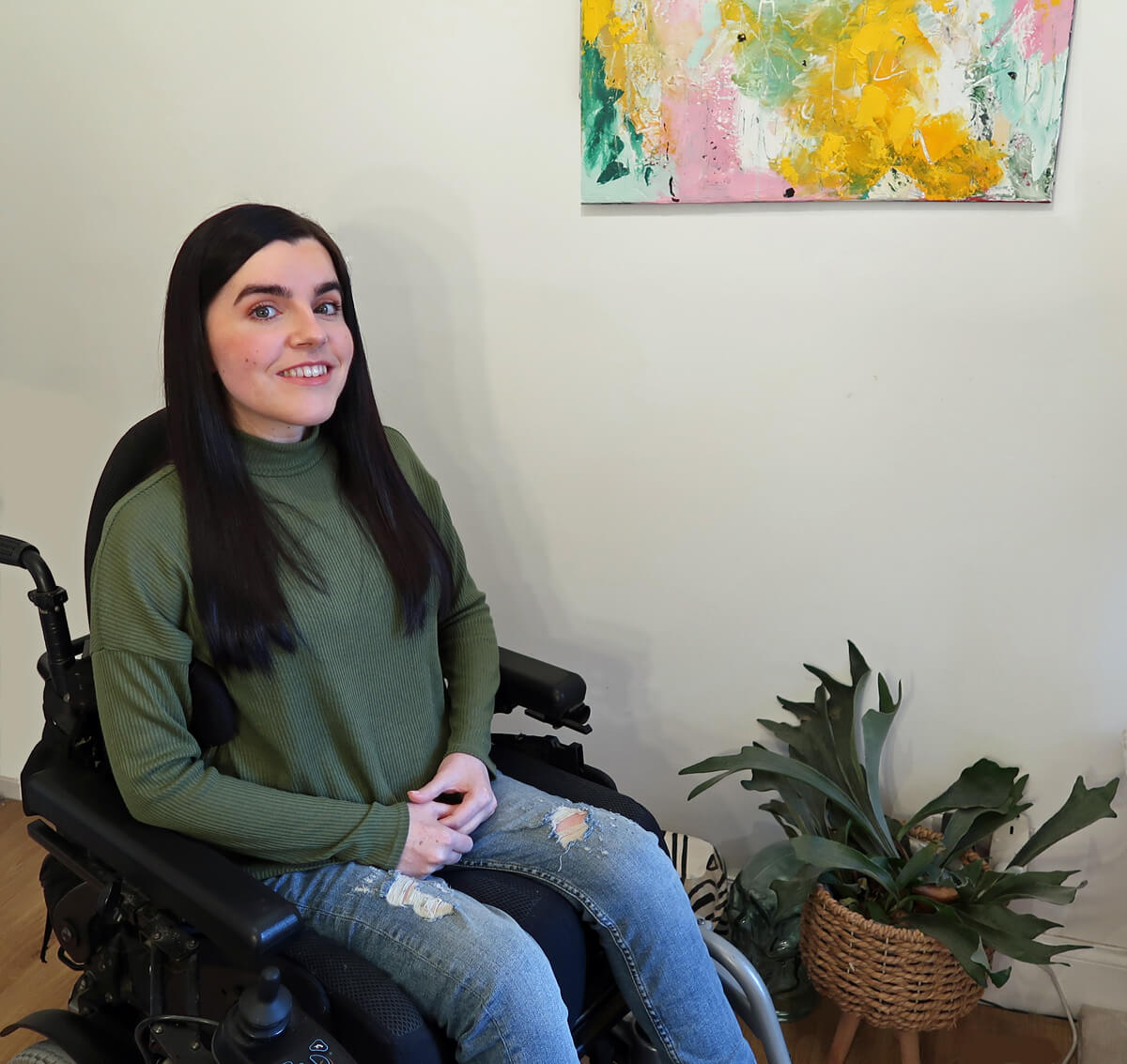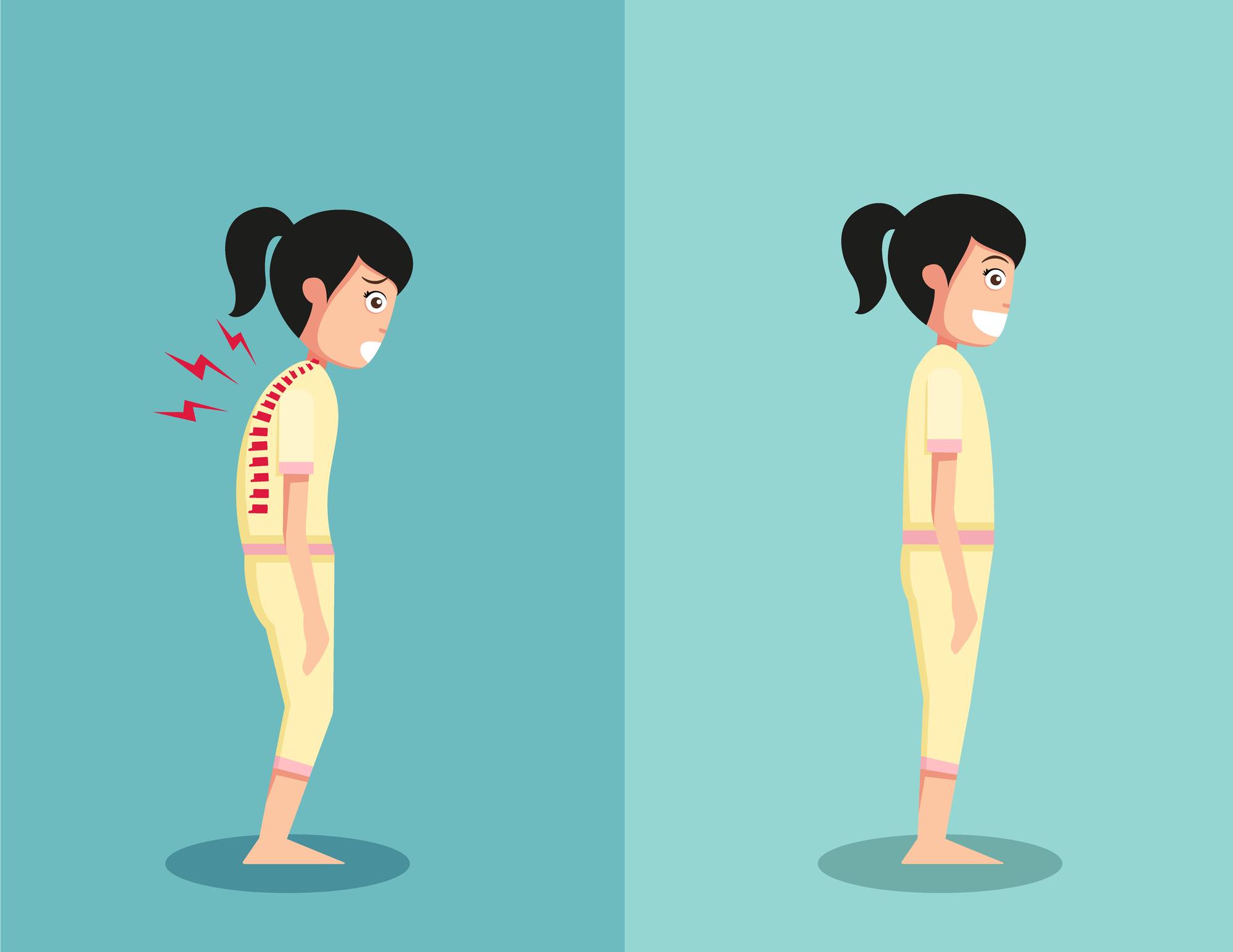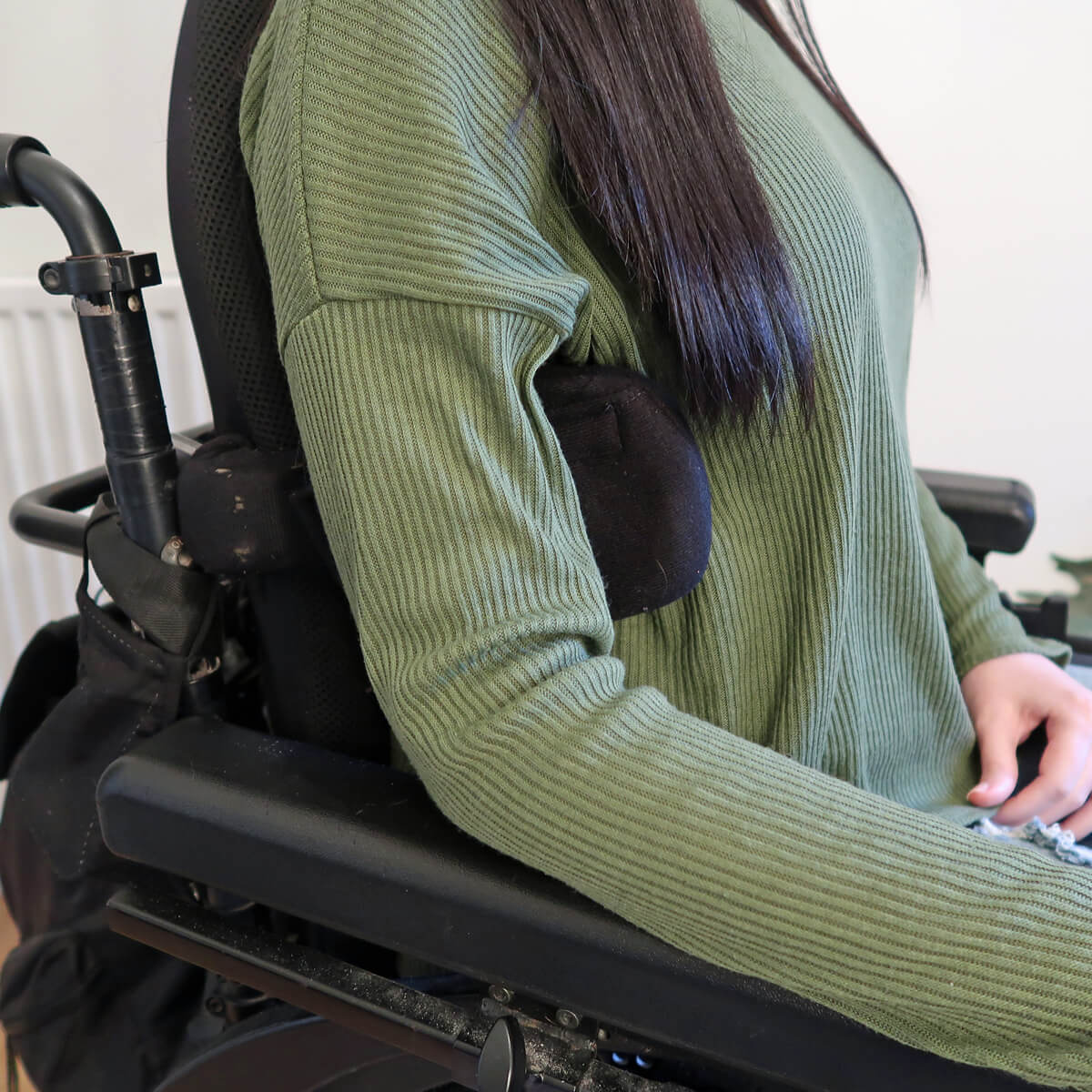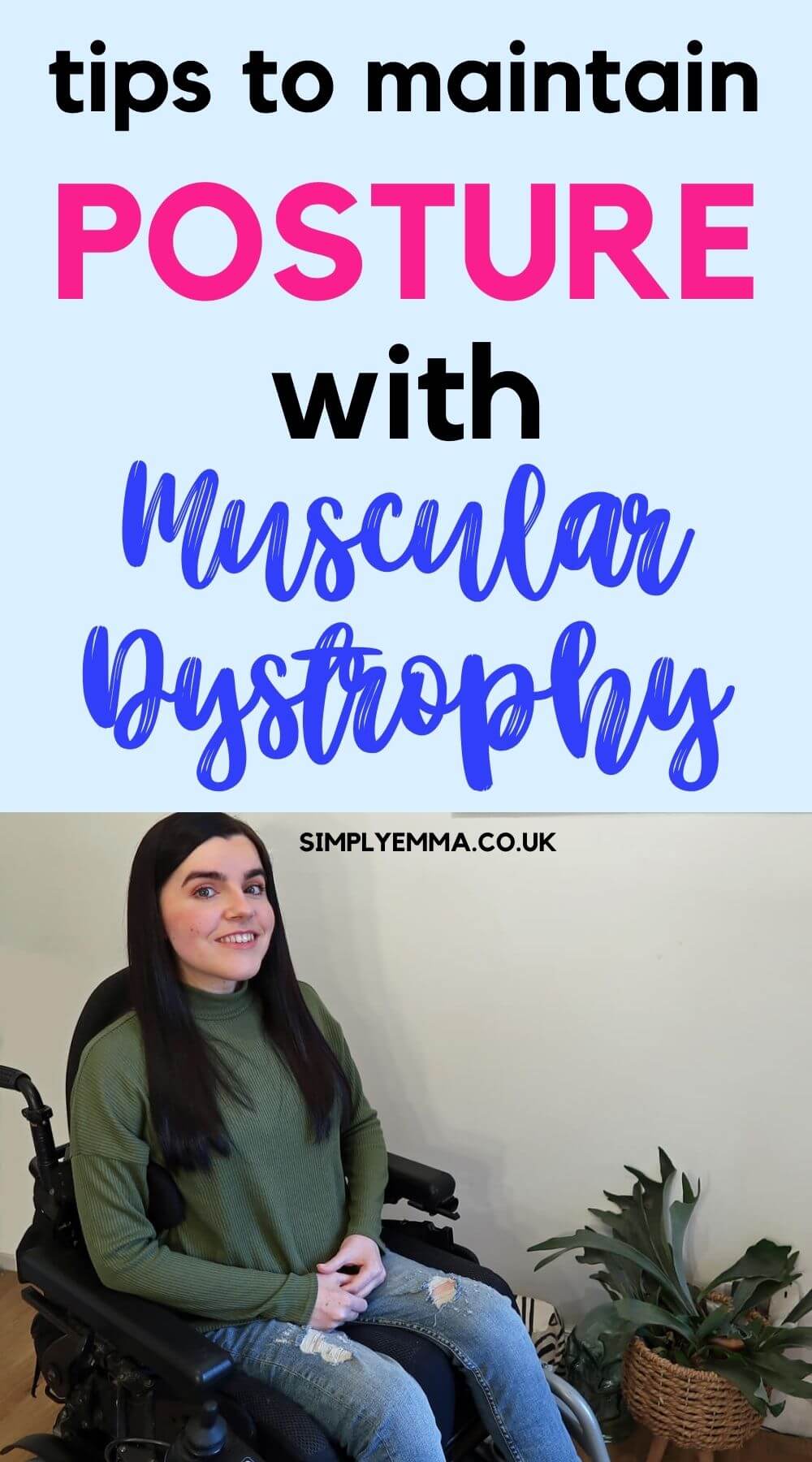Good posture is something we should all be aware of, but more so for people with Muscular Dystrophy. Poor posture can affect our neuromuscular conditions in many ways so it’s important we understand the different ways our posture changes due to Muscular Dystrophy and how we can manage our health, both now and long-term.
What is Posture
Posture is the way in which we hold our bodies in positions while standing, sitting or lying down. There are two types of posture.
- Dynamic: how we hold ourselves upright against gravity when we are moving (walking, running, bending etc)
- Static: how we hold ourselves when we aren’t moving (sitting, lying, standing, sleeping, generally relaxing)
Posture and Muscular Dystrophy
Ever since I can remember, I’ve always been told by my neuromuscular specialists and physiotherapists how important my posture is. And it surprised me how many factors can affect posture including pain, muscle activity and muscle strength, in particular, weak muscles.
Weak muscles will cause postural changes gradually over time, pulling our bodies into awkward positions and can lead to problems such as scoliosis of the spine. This can also lead to joint pain and muscle fatigue.

Dynamic Postural Management
Muscle weakness and the way we move them cause strain on the joints. And since dynamic posture is the way in which we hold ourselves upright against gravity when moving, it’s important we have good dynamic posture for as long as possible.
This helps maintain a good range of movement in our joints as over time the muscles will shorten (i.e contractures). As Muscular Dystrophy is a progressive muscle wasting condition, the muscles work and move differently.
Like many people with MD, I walked with a “waddle” – leaning side to side with my lower back arched (significantly curved with my tummy pushed forward) in order to keep myself upright for standing and walking.
This took a massive toll on my body which caused my muscles to fatigue faster. I would also toe-walk or drag my toes because lifting my feet became more difficult and tiresome. As a result, I had many trips, falls, broken bones and torn ligaments. Ouch!
The muscles have to work harder in situations when:
- Walking on uneven ground.
- Walking in bad weather such as rain, wind and snow (our muscles tense up, and we use more energy and fatigue quicker).
- Walking up/down steps, stairs or kerbs.
How can I manage and support my dynamic posture?
- Speak to your physiotherapist for advice.
- The use of a mobility aid may help e.g wheelchair, walking aid, splints, supports etc.
- Exercises and stretches.
Read more: Walking vs Wheelchair: Accepting the Need for a Wheelchair
Static Postural Management
Static posture is all about the position of our bodies when we aren’t moving around. This is everything from standing, sitting and lying down. Basically, the way in which we hold ourselves when relaxing.
Although we may think that by sitting in a chair or wheelchair we are relaxing our bodies/muscles, the truth is we aren’t.
In fact, our muscles are actually still having to work hard to keep us in that position so changing position often is key. This will ensure the same muscle groups are being used in different ways to prevent muscle fatigue and help keep both sides of our bodies symmetrical.
Standing Posture: How can I manage my static posture while standing?
It may not be surprising to know that standing can be tiring as it requires our muscles to work hard. But there are ways to help your posture and prevent as much strain on your body as possible. You can try:
- Leaning on something. Leaning against a wall can help distribute some weight.
- Rest breaks. If you can, take a break by sitting for a few minutes before standing again. Repeat as often as needed.

Sitting Posture: How can I manage my static posture while sitting?
The same goes for sitting for long periods of time so it’s important to give them a break every so often. Depending on your situation or needs, you may need to change your position every 10, 20 or 30 minutes which isn’t always ideal or realistic.
If you are able, change position by standing up. However, if like me, you are unable to stand, then simple posture changes like sitting forward and back will help.
Leaning to one side is fine but it puts our bodies into asymmetrical positions which then causes our muscles to be used in an imbalanced way.
Ideally, we should make sure we lean to the other side as well and then straight back up in the middle. It can be difficult to remember and trust me I know, but it definitely helps the more you do it.
Other ways to manage static posture with sitting:
- Sit facing straight ahead. Don’t sit at an angle Face people straight on when talking to them to prevent twisting your neck and back.
- The 90/90/90 rule. Hips, knees and ankles should be at 90 degrees when sitting. My wheelchair footplates are positioned at a 90-degree angle and when I wore leg/ankle splints as a child they would always make the ankle position at 90 degrees to prevent tendons from shortening.
- Support your arms and shoulders. To reduce strain on your shoulders, always try to place your arms on a table, armrests or a pillow on your lap. My physiotherapist advised me to do this and it helps massively to support the muscles and joints. Even when I am watching TV I will place my arms on a pillow in front of me on my lap.

Lying down Posture: How can I manage my static posture while lying?
But what about our posture when we are lying down? Surely, it doesn’t matter about supporting our posture because our bodies are relaxed?
Unfortunately, that’s not true. Maintaining a good posture while lying down is still important, maybe even more so.
Because our bodies are in a relaxed state it’s much easier for us to get into awkward postures that are asymmetrical. So when we are lying down it’s best to give our muscles extra help to hold them in supportive, symmetrical positions.
I’ve previously touched on the importance of a good night’s sleep when you have Muscular Dystrophy because it enables our muscles to recover and repair from our daily activities. You can read about this and more of my easy self care tips to relieve muscle fatigue.
Ways to manage static posture with lying down:
- Side sleeper. Support your arm on a pillow. Ensure your back, neck and shoulders are in a good position by placing a pillow between your knees to support your legs. If possible, change to the other side to relieve pressure. This will also make sure you are evenly using the muscle groups on both sides.
- Back sleeper. Support your arms and legs with pillows. This will reduce pressure building up and provide support to your muscles and joints.
- Frequent position changes or unable to move independently. If your sleep is often broken or you can’t turn yourself, a good solution may be a sleep system. I am a back sleeper and I have a sleep system, which is basically pillows and supports that keep me in a super comfortable lying posture. The sleep system relieves pressure and supports me in all the right places to ensure my muscles are fully supported and relaxing in a good position. If you think you’d benefit from a sleep system, I’d recommend speaking to your physiotherapist, OT, social worker etc for a more custom sleep system.
The photo below is an old photo of our DIY sleep system. Unfortunately, I don’t have a recent photo showing my setup, but it is very similar to this.

Wheelchair Posture: How can I manage my static posture while sitting in a wheelchair?
As a full-time power wheelchair user with Limb Girdle Muscular Dystrophy and someone who can’t independently change my position, I need to be aware of how I’m sitting and make sure I’m fully supported.
My wheelchair has a tilt-in-space function to enable me to change position and ease pressure throughout the day. Unfortunately, I don’t have a recline function but this is something that will help you change into different positions.
I also have a custom mould seat cushion which is made to my exact shape and size to give me the best support for my particular needs. A headrest gives neck support and wheelchair laterals for trunk support.
The wheelchair lateral trunk supports are especially helpful when I’m travelling in my Wheelchair Accessible Vehicle (WAV) as it holds me in a comfortable upright posture instead of falling side to side with every turn in the road.

Although these supports help maintain good posture while sitting in a wheelchair, it is still best to come out of your chair throughout the day. This is because our muscles are still getting tired when sitting.
I use my Molift Quick Raiser sit-to-stand hoist for transfers which helps change my position but I often and particularly if I’m sore, I will come out of my wheelchair and lay in bed for a while to allow my body to rest in a different position.
Summary
Maintaining good posture when you have Muscular Dystrophy helps keep your muscles and joints healthy as well as reduce pain and fatigue. Poor posture can affect all aspects of our life from home to social and work life. I hope this guide can be of help to you as it has been to me from the advice of my neuromuscular physiotherapist. I would highly recommend you speak to your physiotherapist or specialist for expert advice and a postural management assessment.
Please let me know in the comments below what you do to maintain a good posture. It will be great for us all to share what works for each other.


To find out a little more about how LGMD affects me, check out the articles below.
What is Limb Girdle Muscular Dystrophy (and how does it affect me)?
5 Things I Do Differently Living With Muscular Dystrophy
How I transfer to and from my wheelchair using a Molift Quick Raiser Mobile Hoist
Parenting A Child With Muscular Dystrophy | Q&A With My Parents
Follow me on Twitter | Facebook | Instagram | YouTube’ | Pinterest
Sharing is caring!





4 Responses
Emna absolutely love this article thank you for sharing!
Aww thank you Kerry – I’m glad you enjoyed it and hopefully found it helpful 🙂
Good article Emma, It’s easy to forget to move.
Thank you, Vincent. I’m glad this post has been helpful. Take care 🙂